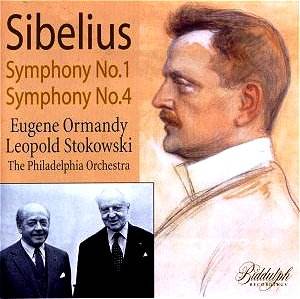Both Ormandy and Stokowski are doughty Sibelians and
both had long tenures in Philadelphia. Stokowski held the chief conductorship
until handing over to Ormandy. Stokowski gave the Cincinnati premieres
of Sibelius's first two symphonies in 1910 and 1912 and conducted the
US premieres of Symphonies 5 (in October 1921) and 6 and 7 (both
in April 1926). Ormandy recorded symphonies 1, 2, 4, 5 and 7 (the disdain
for symphonies 3 and 6 by so many conductors seems inexplicable to me)
with Columbia during the period 1943 to 1968 and you can still hear
his 2 and 7 on a Sony Essential Classics on SBK 53 509. He recorded
the Second, Fourth and Fifth Symphonies again while with RCA post-1968.
In 1976 Stokowski also returned to the recording studio; this time in
London with the National Philharmonic for the Sibelius First Symphony.
That recording can still be heard on a just deleted Sony Essential Classics
double complete with Thomas Schippers' Sibelius Second and the Francescatti
version of the Violin Concerto.
Ormandy was returning to Sibelius 1 for the recording
that now surfaces on this Biddulph recording. In 1935 he had recorded
the work with the Minneapolis Symphony. I hope to hear that recording
soon (recorded on a Lys Dante - the same label that also has Nikolai
Anosov's USSRSO recording from the early fifties). Going by Edward Johnson's
notes (which I confess to having plundered) the Philly version is superior
to the Minneapolis being with a noticeably better orchestra. Overall
the Philadelphia is tauter taking only eight 78 sides rather than the
ten for Minneapolis. This version is given an often relaxed performance
but in a way that never leaves us in doubt that this is a world class,
probably supreme, orchestra. They have invincible unanimity of attack
in the first movement matched by a guileless unglamorous modesty at
the end of the andante. As an interpretation this is not the
match for Barbirolli's stereo First recorded as part of the complete
Barbirolli Sibelius on EMI. The Phildelphians are on much better
form than the 1960s Hallé probably ever were but this version
is in the top quartile and Sibelians need to hear it.
Ormandy's speed in the Lemminkainen 's Return the
orchestra holds onto articulation by the skin of their gritted teeth
and the work of strings and brass is phenomenal. This is easily the
superior of the Beecham Return and is extremely, in fact breathlessly,
exciting. To get a handle on the orchestra's whip-crack precision and
character listen to the opening note which goes with 'whump' of a petrol
aerosol ignition.
This has made me all the keener to hear Ormandy in
his 1950s monos of symphonies 4 and 5, not to mention his much later
1970s RCAs of the same two symphonies (on a couple of RCA Navigator
CDs). I also have high hopes of encountering the 1950s Ormandy Lemminkainen
Legends and being able to contrast these with his late 1970s EMI
recording.
The Stokowski Berceuse has a swan-ripe lip-luscious
velour to the starry strings such that I thought of the 1965 Mravinsky
Swan of Tuonela with the Leningrad Philharmonic. Great Sibelius
playing then and be warned that it will spoil you for most other recordings.
Stokowski breathes such significance and meaning into this miniature
and ladles on the personality far more than he does in the Fourth Symphony.
As is much more evident from Pearl's unvarnished reproduction
of recordings of the Scriabin Prometheus and Poem of Ecstasy
the string section of the Philadelphia was decimated in the 1930s.
Stokowski, ever the technical opportunist, compensated rather well in
the Fourth Symphony sessions by placing the microphones that much closer
to the strings. This has done its work. RCA Victor executives must however
have gone to the recording sessions with heads fatalistically bowed
when Stokowski insisted on the Fourth Symphony - the toughest and least
instantly alluring of the seven. He had already affronted Philadelphia's
subscription series dowagers by not only inflicting on them the Fourth
but repeating it at the same concert at which it was hissed.
It is extraordinary to think that this was the first
Sibelius symphony to be recorded in the USA and the world premiere recording
of the Fourth. The set was never issued on 78 outside the USA.
Portamento and ripe-bursting woodwind tone make the
allegro molto vivace (II) as striking sounding as the strings
in the Tempest - Berceuse and there are parallels
between the two works. By the way in the third movement (tempo largo)
at 3.58 and 4.10 the woodwind evince some momentary damage or defect
to the master. Stokowski takes things at a pretty broad tempo largo.
The brooding and trance-like end of the tempo largo carries
over into the long final allegro. The panoramic effect is low-key
unglamorised and very understated. It is as if Stokowski, defying
the image-makers, bows discreetly into the background, keeping the music
to the fore without apologies and without spotlight. This recording
is evidence of the conductor's humility rather than his showmanship.
Good thorough, extensive English-only notes by Edward
Johnson - much fuller than Malcolm Walker's for WHL 055. Both this disc
and WHL 055 (Beecham Symphony No. 2, Tapiola etc) were issued
in 1998.
Rob Barnett


